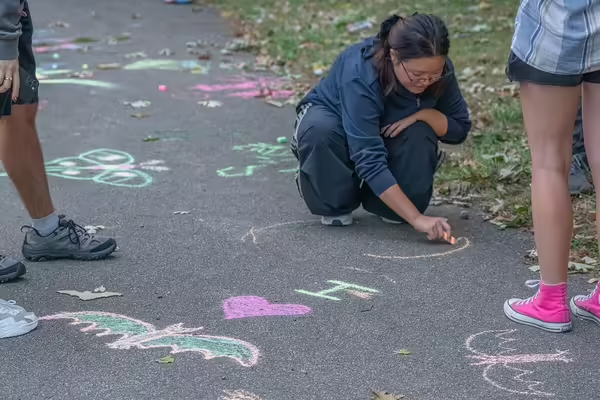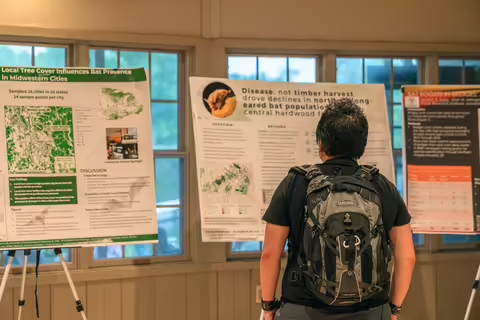
URBANA, Ill. — Bats are an iconic symbol of spooky season, and more than 800 people attended the first Central Illinois Bat Festival on Sept. 28 in Urbana for a celebration of all things batty, including exhibits on bat conservation, guest speakers, activities for kids, and an evening bat walk.
Thanks to Halloween festivities, fall is an opportune time for bat programs. Ironically, fall is a tricky time of year to catch a glimpse of this often misunderstood flying mammal. As the weather turns cold, local bats either begin migrating south or start their winter hibernation.
Illinois is home to 13 species of bats, and about half of them are listed as state-endangered, threatened by changing landscapes, disease, climate change, declining insect populations, and more. Bats provide vital ecosystem services that benefit humans, such as eating hundreds of insects every night, many of which are agricultural pests or have a negative impact on human health.
Joy O’Keefe, associate professor, University of Illinois department of natural resources and environmental sciences and wildlife Extension specialist, was one of several bat experts on hand raising awareness about the issues bats are facing. Her research focuses on understanding bat biology, their roles in ecosystems, and how our conservation efforts may help or harm the unique creatures.
“Bats tend to be personified as scary villains, but bats actually do humans a lot of favors by eating insects and pollinating plants,” said O’Keefe. “It’s encouraging to see public opinion shifting about bats with so many people attending the festival to celebrate them and learn how to help them.”
O’Keefe hosted the community event along with the Urbana Park District and other university partners from the Illinois Natural History Survey, Carl R. Woese Institute for Genomic Biology, and School of Art & Design. The hands-on event included demonstrations of how to use bat monitoring devices, experts sharing how they study bats, and exhibits featuring information about local bat populations.
“It was great to see such an amazing turnout for the first annual bat festival. People were very interested in learning more about bats in Illinois, and there were activities for all ages,” said Brittany Rogness, a bat specialist with the Illinois Natural History Survey.
Savannah Donovan, environmental program manager with the Urbana Park District, noted that Anita Purves Nature Center, Busey Woods, and Crystal Lake Park provided an ideal location for this festival. “The Urbana Park District is looking forward to seeing the Central Illinois Bat Festival grow in the future,” Donovan said.
There are many ways to help support bats. Landowners and homeowners with trees on their property can leave dead and damaged trees to provide roosting habitat. Those with access to garden plots can plant a selection of flowering species that support insect populations, providing insectivorous bats with a more varied diet. Explore more tips in the guide Managing Forests for Bats in Illinois, available for free at go.illinois.edu/ForestryforBats.
Anyone with questions about supporting wildlife or encounters with them can connect with their local Illinois Extension office at go.illinois.edu/ExtensionOffice. Learn more about O’Keefe’s research projects with the Human-Wildlife Interactions Lab.
SOURCE: Joy O’Keefe, associate professor Department of Natural Resources and Environmental Sciences and Wildlife Extension Specialist
University of Illinois Extension develops educational programs, extends knowledge, and builds partnerships to support people, communities, and their environments as part of the state's land-grant institution. Extension serves as the leading public outreach effort for University of Illinois Urbana-Champaign and the College of Agricultural, Consumer and Environmental Sciences in all 102 Illinois counties through a network of 27 multi-county units and over 700 staff statewide. Extension’s mission is responsive to eight strategic priorities — community, economy, environment, food and agriculture, health, partnerships, technology and discovery, and workforce excellence — that are served through six program areas — 4-H youth development, agriculture and agribusiness, community and economic development, family and consumer science, integrated health disparities, and natural resources, environment, and energy.
